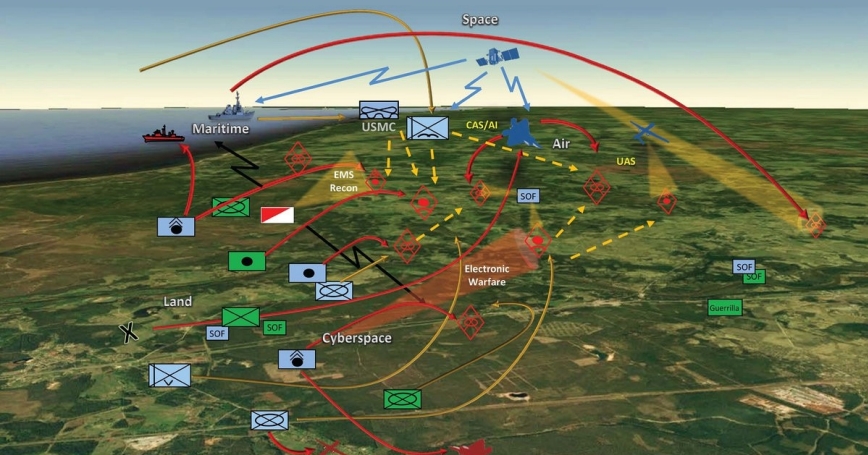The Northrop Grumman radio will provide one-stop access to four types of radio communications widely used by all services for air-to-air and air-to-ground communications.

Multi-Domain Operations, Army Training & Doctrine Command image
Northrop Grumman has won a $14.5 million chance to prove to the Air Force that its design for a new radio would allow operators to use multiple US and allied data links and help the service realize its plans for the Advanced Battle Management System (ABMS).
Importantly, the new Software Programmable Open Mission Systems (OMS) Compliant (known as SPOC) radio terminal will allow the Air Force to rapidly develop and prototype upgrades or change or to third-party contractors to do so. In other words, the software code is not proprietary to Northrop Grumman.
“Our solution for SPOC provides a mature hardware and software development kit that allows the Air Force to rapidly develop and prototype innovative communications solutions from any provider on an open architecture networking terminal that can be quickly taken into flight test and production,” Roshan Roeder, vice president of Northrop Grumman’s communications, airborne sensors and networks division, said in a company release.
“With the Air Force taking responsibility for developing the airborne communications network infrastructure for the Advanced Battle Management System, SPOC radio will allow the Air Force to rapidly develop, test, fly and iterate,” she added.
While already acute, this problem is looming even larger as the Air Force pushes development of ABMS as a key node in DoD’s effort to solidify plans for the development of a Joint All-Domain Command and Control (JADC2) system. JADC2, if successful, will link all sensors and shooters at all levels of military operations (from troops in the field to four-stars at combatant command headquarters) to underpin multi-domain operations (MDO).
 |
Northrop Grumman’s multi-function radio prototype
|
The Northrop Grumman radio will provide one-stop access to four types of radio frequency communications widely used by all services and some allies for air-to-air and air-to-ground communications:
- Link-16 CMN-4, an upgrade to the ubiquitous communications link used by military aircraft, ships, and ground forces to exchange tactical information in near-real time, developed by Naval Information Warfare Systems Command;
- Common Data Link (CDL), one of the oldest (dating from the 1990s) secure military communications protocols that serves as a primary link for sharing imagery and signals intelligence;
- Multifunction Advanced Data Link (MADL), which Breaking D readers know is the hard-to-detect waveform used by the stealthy F-35 Joint Strike Fighter, which can unfortunately only talk to other F-35s; and,
- Multi User Objective System (MUOS), the narrowband, ultra-high frequency satellite communications network developed by the Navy, but used by all the services for mobile communications.
The “open architecture networking terminal offers numerous benefits” to the Air Force, according to Northrop Grumman, “including opening the F-35 communications, navigation and identification (CNI) system to third-party developers; ownership of Link 16 development; sharing of intelligence, surveillance and reconnaissance information over a common data link; and Mobile User Objective System beyond line of sight capability.”